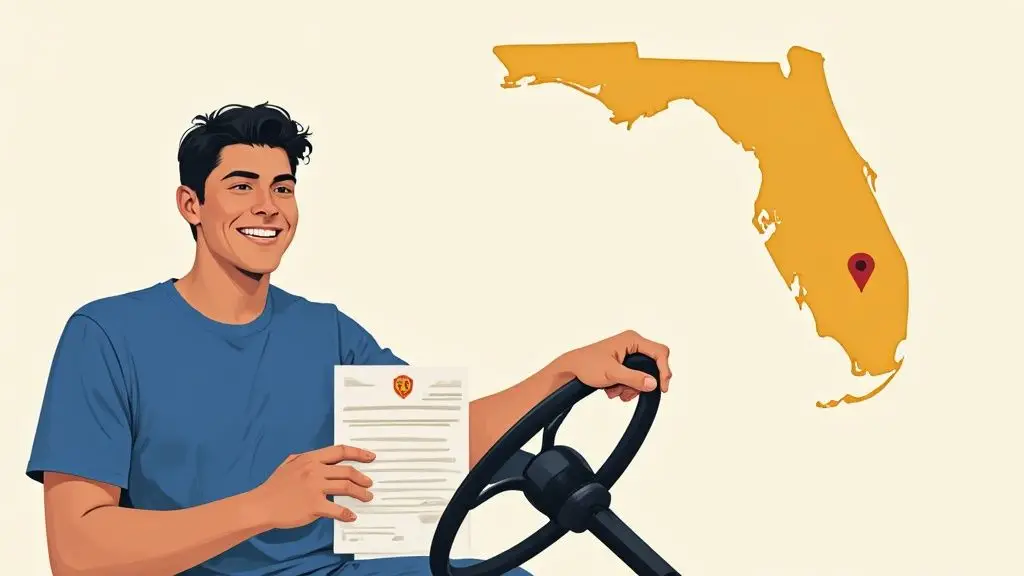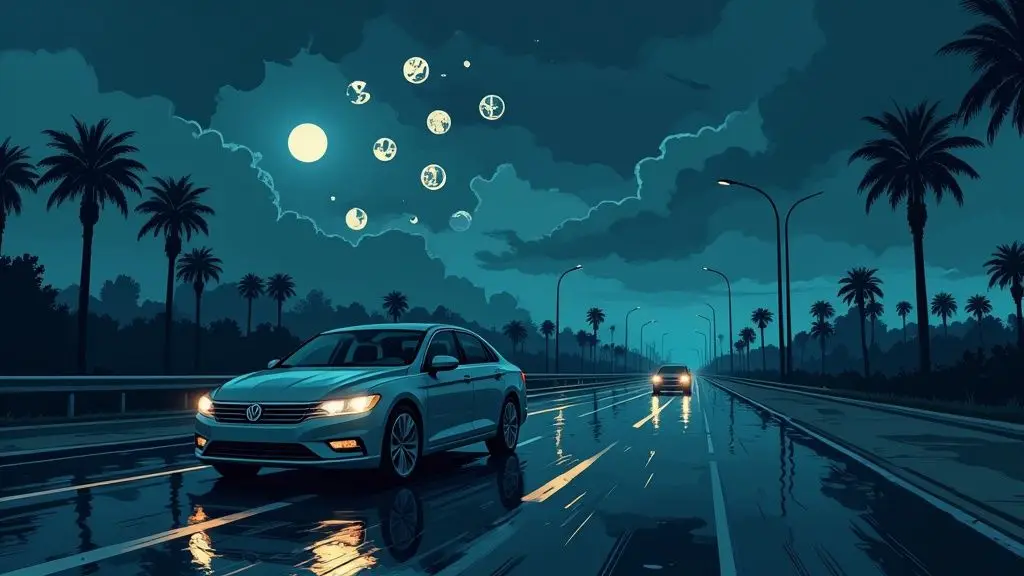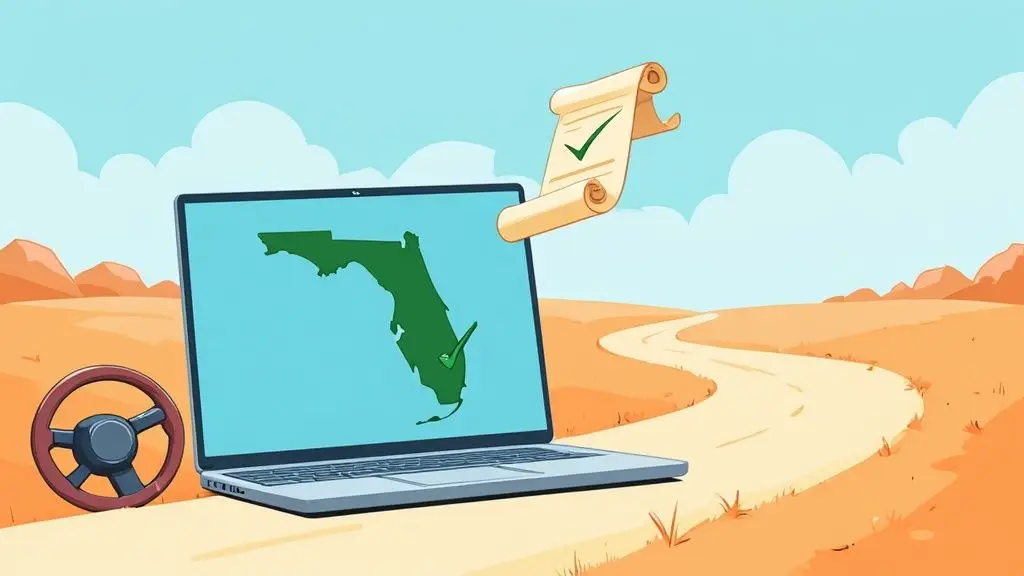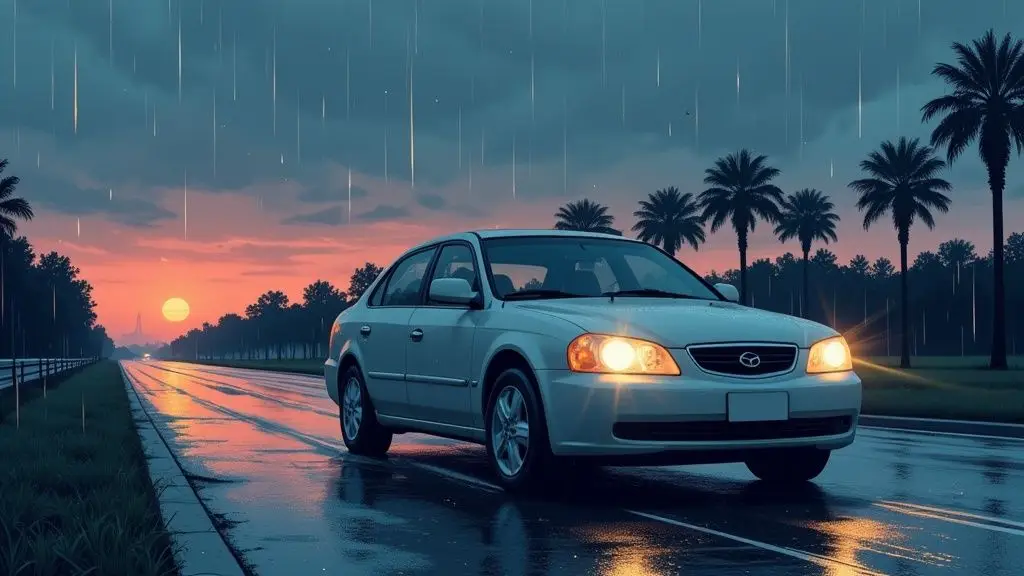It’s a scary thought. A quick text at 55 mph is like driving the length of a football field with your eyes closed. This single glance shows how a small action can have huge results. In fact, using a cell phone while driving creates a trifecta of dangerous distractions. This habit greatly raises the risk of a traffic collision.
The Three Types of Driving Distractions
To understand the danger, you need to know how a phone steals your focus. First, safety experts divide distractions into three types. The scary part is that a cell phone triggers all three at once. As a result, this creates a perfect storm for a crash.
The image below shows how cell phone bans are spreading. More importantly, it also tracks the tragic number of fatalities from distracted driving.
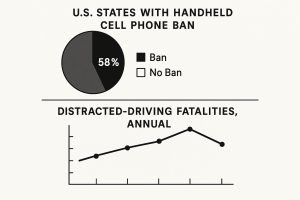
As you can see, the number of lives lost is still very high, even with more laws. This is not just about rules. Instead, it is about choosing to stay focused every time you drive.
A cell phone pulls your eyes off the road. It also pulls your hands off the wheel and your mind off of driving. Here’s a breakdown of how it all falls apart.
The Three Types of Driving Distractions
| Type of Distraction | What It Means for a Driver | A Real-World Cell Phone Example |
|---|---|---|
| Visual | Your eyes are not on the road ahead. | Reading a text message or checking a notification on your screen. |
| Manual | Your hands are not on the steering wheel. | Holding your phone, typing a response, or scrolling a playlist. |
| Cognitive | Your mind is not focused on the task of driving. | Thinking about your conversation instead of potential road hazards. |
Each of these distractions is dangerous alone. However, when you combine them, you are not really driving anymore. You are just a passenger in a moving vehicle.
Visual: Eyes Off The Road
The most obvious danger is a visual distraction. Any time your eyes leave the road to look at your phone, you’re driving blind. Even a split second is too long. Consequently, you are not seeing the brake lights ahead. You miss the pedestrian in the crosswalk or the light that just turned red.
Manual: Hands Off The Wheel
Next comes the manual distraction. This happens when you take one or both hands off the steering wheel. For example, you might hold your phone to type or swipe. In that moment, you have lost your ability to react quickly to an emergency. This could be swerving to avoid a pothole or another car.
Cognitive: Mind Off The Drive
Perhaps the most hidden danger is cognitive distraction. This is when your mind is not on the road. Your eyes might be on the road and your hands on the wheel, but your focus is elsewhere. Your brain is busy with a conversation. Therefore, it is not scanning for and processing what is happening around you.
A driver’s brain can be distracted by a conversation. They can miss seeing up to 50 percent of what is around them, like pedestrians and red lights.
The real-world toll of these distractions is huge. According to the National Highway Traffic Safety Administration (NHTSA), more than 3,300 people were killed in 2022. In addition, almost 290,000 were injured in crashes involving a distracted driver. It’s not just other drivers at risk, either. Nearly one in five of those killed in these incidents were people outside a vehicle, like pedestrians and cyclists.
Understanding the Different Types of Cell Phone Laws
Keeping up with cell phone driving laws can be confusing. The rules change from state to state. However, they generally fall into a few key categories. Once you understand these, you will have a clearer picture of what is expected of you behind the wheel.
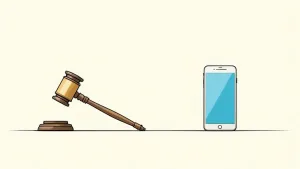
First, it is important to understand how these laws are enforced. This is the biggest difference you will see on the road. Enforcement comes in two types: primary enforcement and secondary enforcement.
- Primary Enforcement: This is simple. If a police officer sees you breaking a cell phone law, they can pull you over for that reason alone. It is a standalone violation, just like speeding or running a red light.
- Secondary Enforcement: This type is less common now. With secondary enforcement, an officer cannot pull you over just for being on your phone. First, they must stop you for another primary offense, like a broken taillight. Only then can they add a cell phone ticket.
Most states now use primary enforcement for their cell phone laws. This is because it is a much more effective way to stop distracted driving.
The Most Common Cell Phone Bans
Beyond how laws are enforced, it is about what they ban. These rules have changed a lot since New York became the first state to ban holding a phone while driving in 2001. Today’s roadway laws are often much more specific and strict.
As of today, 20 U.S. states have a complete ban on drivers holding any electronic device. The rules are even tighter for young drivers. In fact, 33 states and Washington D.C. have a total ban on all cell phone use for teen drivers—and that includes hands-free. The Insurance Institute for Highway Safety (IIHS) has more data if you want to learn more.
Key Differences in Driving Rules
The regulations you must follow often depend on your age. They can also depend on where you are driving, like a school or construction zone. Knowing these details is key to staying safe and avoiding tickets.
- Texting Bans: This is the baseline rule. Almost every state has a law that makes it illegal for all drivers to text and drive.
- Handheld Bans: This is a big step up from just texting. These laws make it illegal to hold your phone at all while driving. This means no talking, no programming your GPS, and no scrolling through a playlist.
- Novice Driver Bans: States often have a zero-tolerance policy for new and young drivers. They are at a much higher risk of crashing. Therefore, many laws forbid them from using a phone in any way, even with a hands-free device.
Learning about these different laws helps you prepare for the road. Before you drive, it is always smart to check the specific rules for your state. A great resource for this is the state-by-state overview from the Governors Highway Safety Association (GHSA).
A Closer Look at Florida’s Driving Laws
We have covered the basics of cell phone laws in general. Now, let’s look closely at a specific state to see how these rules work. We will use Florida as our example. It is a state with millions of drivers and some very clear laws about distracted driving.

The main law you need to know is the “Wireless Communications While Driving Law.” This law makes it illegal to type on your phone while your car is moving. This includes typing letters, numbers, or symbols. In short, it means no texting, emailing, or sending direct messages.
Texting is a Primary Offense
Here is the most important point: Florida treats texting while driving as a primary offense. This is a big deal. It means a police officer can pull you over and give you a ticket just for seeing you text.
They do not need any other reason, like speeding or a broken taillight. This change gave the law real power. Getting a ticket can lead to points on your license and other problems.
Stricter Rules for Sensitive Areas
The law is even more serious when you drive through high-risk areas. In these special zones, you cannot even hold your phone.
- School Zones: When you’re in a marked school crossing or school zone, holding a phone is not allowed.
- Work Zones: The same hands-off rule applies in active construction zones where workers are present.
Simply put, you cannot have your phone in your hand in these areas. This rule is in place to demand your full attention when it matters most.
Florida Statute 316.306 is very clear on this. The only legal way to talk on the phone in a school or work zone is with a hands-free device. This keeps your hands on the wheel and your mind on the road. You can always read the exact law on the state’s official legislative site, FLsenate.gov, to stay informed.
The True Cost of a Distracted Driving Ticket
A ticket for texting and driving is more than just an inconvenient delay. It is the start of many costs and issues that can follow you for years. The fine on the citation is just the beginning.
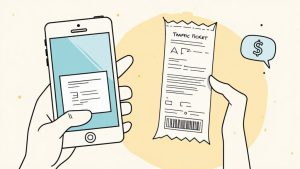
The fine is the first hit to your wallet. A first-time offense might be small. However, the penalties increase a lot for future violations. What seems like a minor expense can become a major financial problem if you are caught again.
Points on Your Driving Record
Besides the fine, a ticket adds points to your driving record. These points are like black marks that the state and your insurance company watch closely.
Getting too many points in a certain time leads to serious trouble. For example, your license could be suspended. These points do not disappear quickly. They stay on your record for years. They show a history of risky behavior to anyone who checks, including future employers.
The Long-Term Insurance Spike
Here is where the real financial pain begins, and it lasts a long time. When your insurance company learns about the ticket, they see a big red flag.
To them, you have become a much riskier driver. You are statistically more likely to cause a collision. As a result, they will raise your insurance premiums. This rate hike can last for several years. It can easily add up to hundreds or thousands of dollars over time. This makes the original fine seem tiny.
A single distracted driving conviction can raise your car insurance rates by an average of 20% to 30%, according to industry analyses. This “ticket tax” can follow you for three to five years, depending on your insurer’s policies.
Practical Habits for Distraction-Free Driving
Knowing Florida’s cell phone laws is one thing, but following them is another. The real key to safety is building smart habits. These habits make focusing on the drive automatic. It is all about setting yourself up for success before you even start the car.
The easiest way to avoid temptation is to remove your phone from the equation. A few small changes to your routine can make a huge difference. These steps can turn your car into a distraction-free zone.
Set Up Before You Go
Get into the habit of handling all your phone tasks while you are still parked. This one small change can lead to a completely focused trip.
- Program your GPS: Enter your destination and start the route before you pull out of the driveway.
- Pick your audio: Set up your playlist, podcast, or radio station ahead of time.
- Send your “on the way” texts: Let people know you are about to start driving so they do not expect a quick reply.
By doing these tasks first, you remove the urge to touch your phone while driving.
Create a Phone-Free Zone
Making your phone physically and digitally out of reach is a powerful step. If you cannot see it or hear it, you are less likely to think about it. Most smartphones have a “Do Not Disturb While Driving” mode. Turn it on! This feature is great. It silences notifications and can even send an automatic reply for you.
Another very effective plan is to just put your phone where you cannot get to it easily.
Here’s a simple trick: put your phone in the glove box, the center console, or a bag in the back seat. Out of sight, out of mind. If you cannot reach it, you cannot be tempted by it. This is a very practical defensive driving technique.
Your Checklist for Safe Driving Habits
To make it even easier, here is a quick checklist. You can use it to build these safe habits into your daily routine.
| Proactive Step | The Safety Benefit | When to Do It |
|---|---|---|
| Set GPS & Audio | Eliminates the need to touch your device while moving. | Before starting the car. |
| “Do Not Disturb” Mode | Silences calls and texts, preventing notifications from distracting you. | Every time you drive. |
| Stow Your Phone | “Out of sight, out of mind” removes the physical temptation to grab it. | Before putting the car in gear. |
| Be a Good Co-Pilot | Helps the driver stay focused and promotes a culture of safety. | When you’re a passenger. |
Adopting these small actions makes a huge impact on your safety. It also helps protect everyone else on the road.
Lead by Example
Never forget that your actions speak loudly. This is especially true for younger, less experienced drivers in the car. When you drive focused, you are teaching them what responsible driving looks like.
And when you are the passenger? Be a great co-pilot! Offer to handle the GPS or send a text for the driver. This teamwork creates a powerful culture of safety for everyone.
The Hidden Dangers of Hands-Free Technology
Most of us think that using a hands-free device is perfectly safe. For example, you might use your car’s Bluetooth system. It seems safe because your hands are on the wheel and your eyes are on the road. However, this common belief misses the real problem: cognitive distraction.
Think about it this way. Have you ever tried to read a book while someone talks to you? You might be looking at the page, but your mind is so busy with the conversation that you do not understand a single word. That is exactly what happens behind the wheel. Your brain can only truly focus on one complex task at a time.
Why Your Brain Can’t Really Multitask
When you are on a phone call, your brain is working hard. It is listening, processing information, and thinking of replies. All that mental energy has to come from somewhere. It gets stolen directly from the focus you need for driving.
Even with both hands on the steering wheel, a driver on a call can miss up to 50% of what is happening right in front of them. This is a real effect called “inattention blindness.” You are technically looking, but you are not truly seeing the pedestrian stepping off the curb or the car ahead braking hard.
The results of this mental overload are huge. Some studies have shown that texting while driving can be as dangerous as driving drunk. A hands-free call might feel safer, but it still uses the brainpower needed to drive safely. You can find more data on the real risks from the U.S. Department of Transportation on their distracted driving page.
The only truly safe call to make while driving is no call at all. Your most important job is to operate your vehicle safely. Any conversation, hands-free or not, interferes with that duty.
Understanding the True Risk
Many laws focus on handheld devices. This is because it is easier for law enforcement to see and enforce. But safety experts will tell you that holding the phone is only part of the problem.
The conversation itself is the real distraction. The safest thing you can do is put the phone away. Then, give the road your full attention until you arrive safely.
Frequently Asked Questions About Driving Laws
Using your phone on the road can be confusing. Let’s clear up some common questions so you can stay safe and on the right side of the law.
What if I Have a Real Emergency? Can I Call for Help?
Yes, absolutely. The law is very clear about this. Every distracted driving law has an exception for true emergencies. If you need to contact police, the fire department, or medical services, you can use your phone. In a crisis, your safety comes first.
How Do I Know the Exact Rules for Where I’m Driving?
Laws can change, and they often differ from one state to another. If you are traveling, it is smart to know the local rules. The best place to find information is always an official source. A great resource is the Governors Highway Safety Association (GHSA). It keeps an updated list of laws for all 50 states. For Florida-specific laws, you can visit the official Florida Department of Highway Safety and Motor Vehicles (FLHSMV) website.
I Use a Hands-Free Device, So I’m Safe, Right?
Not exactly. Using a hands-free device like Bluetooth is legal in many situations. However, “legal” does not always mean “safe.” The real danger is not just about your hands. It is about where your mind is focused. The conversation itself is a powerful cognitive distraction. It pulls your focus away from driving.
Studies from the National Highway Traffic Safety Administration (NHTSA) show the brain stays busy in the conversation. This can slow a driver’s reaction time. Even with both hands on the wheel, your mind is somewhere else. The safest choice is to save the chat for when you are parked.
What’s the Best Thing to Do if I See Someone Else Texting and Driving?
It can be scary to see another driver using their phone. You might want to honk at them. But that can often make things worse by startling them. The safest thing you can do is create distance. Slow down and change lanes if you can. Just put as much space as possible between your car and theirs. Your main job is to protect yourself and your passengers by focusing on your own driving.
